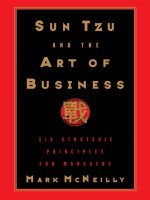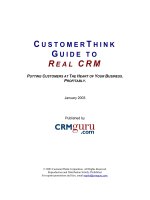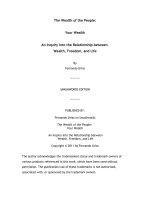The Strategist: Be The Leader Your Business Needs
Bạn đang xem bản rút gọn của tài liệu. Xem và tải ngay bản đầy đủ của tài liệu tại đây (2.65 MB, 386 trang )
THE STRATEGIST
BE THE LEADER YOUR BUSINESS
NEEDS
Cynthia A. Montgomery
Dedication
To Anneke, Mathea, and Nils
That you may find places
where you
can make a difference that
matters
And to Bjørn, forevermore
Epigraph
In the end, it is important to remember that we
cannot become what we need to be by remaining
what we are.
—Max De Pree, CEO of Herman Miller, in
Leadership Is an Art
Contents
Cover
Title Page
Dedication
Epigraph
Introduction - What I Learned in
Office Hours
Chapter 1 - Strategy and Leadership
Chapter 2 - Are You a Strategist?
Chapter 3 - The Myth of the Super-
Manager
Chapter 4 - Begin with Purpose
Chapter 5 - Turn Purpose into
Reality
Chapter 6 - Own Your Strategy
Chapter 7 - Keep It Vibrant
Chapter 8 - The Essential Strategist
Author’s Note
Frequently Asked Questions
Recommended Reading
Notes
Index
Acknowledgments
About the Author
Credits
Copyright
About the Publisher
Introduction
What I Learned in Office
Hours
YOU’RE ABOUT TO get a revisionist view of
strategy. It’s not that what you’ve learned is
incorrect. It’s that it’s incomplete.
Strategy is a fundamental course at nearly every
business school in the world. I have been
privileged to teach variations of it for more than
thirty years—first at the University of Michigan,
then at the Kellogg School at Northwestern, and for
the last twenty-plus years at the Harvard Business
School.
For most of that time I worked with MBA
students, until the center of my teaching shifted to
executive education. It was this experience,
particularly a five-year stint in Harvard’s
Entrepreneur, Owner, President program (EOP),
that inspired this book.
1
Working intimately with
leaders from nearly every industry and nation as
they confronted their own real-world strategic
issues changed not only how I teach strategy, but,
more fundamentally, how I think about it. The
experience led me to challenge some of strategy’s
basic precepts, and ultimately to question both the
culture and mind-set that have grown up around it.
Even more important, teaching in EOP forced me
to confront how strategy is really made in most
businesses, and by whom.
All of this convinced me that it is time for a
change. Time to approach strategy in a different
way and time to transform the process from a
mechanical, analytical activity to something
deeper, more meaningful, and far more rewarding
for a leader.
THE ROAD TO HERE
Fifty years ago strategy was taught as part of the
general management curriculum in most business
schools. In the academy as well as in practice, it
was identified as the most important duty of the
president—the person with overarching
responsibility for setting a company’s course and
seeing the journey through. This vital role
encompassed both formulation and
implementation: thinking and doing combined.
Although strategy had considerable depth then, it
didn’t have much rigor. Heuristically, managers
used the ubiquitous SWOT model (Strengths,
Weaknesses, Opportunities, and Threats) to assess
their businesses and identify attractive competitive
positions. How best to do that, though, was far
from clear. Other than making lists of various
factors to consider, managers had few tools to help
them make these judgments.
In the 1980s and ’90s, my colleague Michael E.
Porter broke important new ground in the field. His
watershed came in firming up the Opportunities
and Threats side of the analysis by bringing much-
needed economic theory and empirical evidence to
strategy’s underpinnings, providing a far more
sophisticated way to assess a firm’s competitive
environment. This led to a revolution in both the
practice and teaching of strategy. In particular,
managers came to understand the profound impact
industry forces could have on the success of their
businesses and how they could use that information
to position their firms propitiously.
Advances over the next few decades not only
refined the tools but spawned a whole new
industry. Strategy in many ways became the
bailiwick of specialists—legions of MBAs and
strategy consultants, armed with frameworks,
techniques, and data—eager to help managers
analyze their industries or position their firms for
strategic advantage. In truth, they had a lot to offer.
My own academic training and research in this
period reflected this intellectual environment, and
what I did in the classroom for many years
thereafter was a living embodiment of this “new”
field of strategy.
In time, though, a host of unintended
consequences developed from what in its own
right was a very good thing. Most notably, strategy
became more about formulation than
implementation, and more about getting the
analysis right at the outset than living with a
strategy over time. Equally problematic, the
leader’s unique role as arbiter and steward of
strategy had been eclipsed. While countless books
have been written about strategy in the last thirty
years, virtually nothing has been written about the
strategist and what this vital role requires of the
person who shoulders it.
It wasn’t until years into this shift that I fully
realized what had happened. It was classic
Shakespeare: As a field, we had hoisted ourselves
on our own petard. We had demoted strategy from
the top of the organization to a specialist function.
Chasing a new ideal, we had lost sight of the value
of what we had—the richness of judgment, the
continuity of purpose, the will to commit an
organization to a particular path. With all good
intentions, we had backed strategy into a narrow
corner and reduced it to a left-brain exercise. In
doing so, we lost much of its vitality and much of
its connection to the day-to-day life of a company,
and we lost sight of what it takes to lead the effort.
Teaching in the EOP program drove these
insights home for me.
When I first started working with the group, I
used a curriculum that was much like one I would
use in any executive program. Through a series of
class discussions and presentations, we discussed
the enduring principles of strategy, the frameworks
that capture them, and a series of case studies that
brought the concepts and tensions alive. We still
do that—and it’s a valuable part of what we do.
But in between class sessions, the EOP students
—all accomplished executives and entrepreneurs
—started to ask if they could meet me in my office
to talk about various situations they were facing in
their companies. These conversations often took
place at unusual hours, and sometimes lasted far
into the evening. Most started out predictably
enough: We talked about the conditions in their
industries, the strengths and weaknesses of their
own companies, and their efforts to build or extend
a competitive advantage. Some discussions ended
there, and a thoughtful application of whatever
we’d been doing in class seemed to meet the need.
Often, though, these conversations took a
different turn. Alongside all the conventional
questions were ones about what to do when the
limits of analysis had been reached and the way
forward was still not clear; questions about when
to move away from an existing competitive
advantage and when to try to stay the course;
questions about reinventing a business or
identifying a new purpose, a new reason to matter.
Even though many of the companies at issue were
remarkably successful (one had grown from a
start-up to $2 billion in revenue in just nine years),
almost none had the kind of long-run sustainable
competitive advantage that strategy books tout as
the Holy Grail.
Working with these managers, typically over
three years, and hearing the stories within the
stories, I came to see that we cannot afford to think
of strategy as something fixed, a problem that is
solved and settled. Strategy—the system of value
creation that underlies a company’s competitive
position and uniqueness—has to be embraced as
something open, not something closed. It is a
system that evolves, moves, and changes.
In these late-night one-on-one conversations, I
also saw something else: I saw the strategist, the
human being, the leader. I saw how responsible
these executives feel for getting things right. I saw
how invested they are in these choices, and how
much is at stake. I saw the energy and commitment
they bring to this endeavor. I saw their confidential
concerns, too: “Am I doing this job well? Am I
providing the leadership my company needs?”
And, more than anything, I saw in these
conversations the tremendous potential these
leaders hold in their hands, and the profound
opportunity they have to make a difference in the
life of a company. In those moments together, we
both came to understand that if their businesses
were going to pull away from the pack, to create a
difference that mattered, it had to start with them.
A NEW UNDERSTANDING
In all our lives there are times of learning that
transform us, that distance us from the familiar, and
make us see it in new ways. For me, the EOP
experience was one of those times. It not only
changed some of my most central views about
strategy; it gave me a new perspective on the
strategist, and on the power and promise of that
role.
In these pages I will share with you what I have
learned. In doing so, I hope that you will gain a
new understanding about what strategy is, why it
matters, and what you must do to lead the effort. I
also hope that you will come to see that beyond the
analytics and insights of highly skilled advisors
and the exhortations of “how-to” guides, there is a
need for judgment, for continuity, for responsibility
that rests squarely with you—as a leader.
Because this role rests with you, The Strategist
is a personal call to action. It reinstates an
essential component of the strategy-making process
that has been ignored for decades: You. The
leader. The person who must live the questions that
matter most.
That’s why my ultimate goal here is not to “teach
strategy,” but to equip and inspire you to be a
strategist, a leader whose time at the helm could
have a profound effect on the fortunes of your
organization.
Author’s Note
The examples and stories in this book are based
largely on five years’ teaching in one of the
comprehensive executive programs at Harvard
Business School. In the pages of this book, I refer
to this program as the Entrepreneurs, Owners,
Presidents program (EOP), though the actual name
of the program is different. You can find more
information about various executive programs the
school offers at www.exed.hbs.edu.
In some cases, companies’ locations or certain
details about them or individuals have been
changed or composites of student experiences have
been created so as not to violate the privacy of
former students. Where names of companies or
individuals are disclosed, it is done with express
permission, and the details in the accompanying
discussions have been approved for release by the
firms.
In some instances, I have presented cases in
class in a different way than they are described
here or used other cases than the ones in this book
to make the same important points.
Chapter 1
Strategy and Leadership
Does your company matter?
That’s the most important question every
business leader must answer.
If you closed its doors today, would your
customers suffer any real loss?
1
How long
would it take, and how difficult would it be,
for them to find another firm that could meet
those needs as well as you did?
Most likely, you don’t think about your
company and what it does in quite this way.
Even if you’ve hired strategy consultants, or
spent weeks developing a strategic plan, the
question probably still gives you pause.
If it does or if you’re not sure how to
respond, you’re not alone.
I know this because I’ve spent the better
part of my life working with leaders on their
business strategies. Again and again, I’ve
seen them struggle to explain why their
companies truly matter. It’s a difficult
question.
Can you answer it?
If you cannot, or if you’re uncertain of
your answer, join me as I explore this
question with a group of executives now
gathering.
It is evening on the campus of the Harvard
Business School. The kickoff orientation to the
Entrepreneur, Owner, President program (“EOP”
for short), one of the flagship executive programs
at the school, is about to begin. Along with five of
my fellow faculty, I sit in the “sky deck,” the last
and highest row of seats, in Aldrich 112, an
amphitheater-style classroom characteristic of the
school, and watch as the newest group of
executives stream into the room.
I see that there are considerably more men than
women, and that the majority appear to be in their
late thirties to mid-forties. Most exude an air of
seasoned self-confidence. That’s no surprise—
they’re all owners, CEOs, or COOs of privately
held companies with annual revenues of $10
million to $2 billion—the kind of small- to
medium-size enterprises that drive much of the
global economy. Most arrived on campus within
the last few hours and have had just enough time to
find their dorm rooms and meet the members of
their living groups before heading here to Aldrich.
The information they provided in their
applications tells part of their stories: Richard, a
third-generation U.S. steel fabricator; Drazen,
CEO of a media firm in Croatia; Anna, founder and
head of one of the largest private equity groups in
South America; and Praveen, the scion of a family
conglomerate in India. But this is just a taste of
their diversity and accomplishments. The richer
details and the breadth of the class will emerge in
the weeks ahead.
As the clock ticks past the hour, some last-
minute arrivals burst through the door. They are
typical first-time EOPers in their lack of concern
about being late. Most of these people hail from
worlds where meetings don’t start until they arrive.
That will change in the coming days, as they make
the adjustment from the top-of-the-line leather
chairs in their offices back home to the standard-
issue seats that line the classrooms. Indeed, for
their time here, they will be without many of the
supports they rely on in their daily lives, such as
administrative assistants and subordinates to whom
they can delegate work and problems. Families are
strongly discouraged from living near campus and
are prohibited from dorms once classes begin.
BlackBerrys and cell phones are allowed, but
never in class.
A final hush settles as the program begins with
an overview of who’s here: 164 participants from
thirty-five countries, with a collective 2,922 years
of experience. Two-thirds of their businesses are
in service industries, the remainder in
manufacturing.
They are here to participate in an intensive
management boot camp for experienced business
leaders. It spans topics in finance, marketing,
organizational behavior, accounting, negotiations,
and strategy, and runs for nine weeks in total,
divided into three three-week sessions spread over
three years. Between sessions, students return to
their businesses and start to apply what they have
learned. Debriefs the following year are an
opportunity for feedback and reflection on what
has worked and what hasn’t. This structure has
given the faculty an exceptional opportunity to
develop a hands-on curriculum that brings theory
and practice much closer together, even for a
school that has always championed the connection.
Why do these talented, seasoned managers from
every major world culture come to this program?
As heads of their companies, why do they elect to
spend tens of thousands of dollars to send
themselves to school?
THE VIEW FROM THE BALCONY
If past participants are any indication, these
executives have not come to seek specific answers
to narrow questions. They have come to learn how
to be more effective leaders and to find ways to
make their businesses more successful. Successful
in what ways, and through what means, for most, is
still an open question. They are here to throw
themselves into the program, to be challenged, to
discover what they might learn in this environment.
This experience will be an important juncture
for many, in their careers and even their lives.
What they learn here will lead them to think in
broader, more far-reaching ways. To explain how
this happens, I’ve always liked the metaphor of a
dance taking place in a great hall.Most dancers
spend all their time on the dance floor, moved by
the music, jostled by dancers around them,
completely absorbed in the flow. But it’s not until
they extricate themselves from the crowd and move
to the balcony above that the larger picture
becomes clear. It is then that overall patterns
become apparent and new perspectives emerge.
Often these reveal opportunities for better choices
about what to do down on the dance floor.
Many EOPers have spent years without ever
leaving the dance floor. Absorbed by the day-to-
day challenges of running a business, they’ve never
gone to the balcony. On one level, our job is to
help them understand the value of going to the
balcony in the first place. On another, it is to equip
them with the tools to see their dances in new
ways, ways that reveal options they may never
have considered before.
THE STRATEGY COURSE
When it’s time for the faculty to introduce their
courses, I stand and give a quick summary of the
work we’ll be doing in strategy. Like most
businesspeople, these managers are likely to be
familiar with at least a vague definition of strategy.
The word itself comes from the ancient Greek for
“general”—specifically for the general on
campaign in the field. In business, strategy is a
company’s campaign in the marketplace: the









